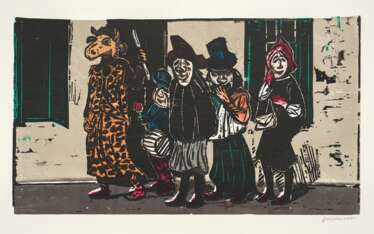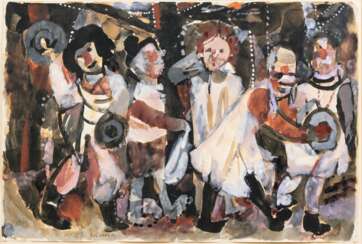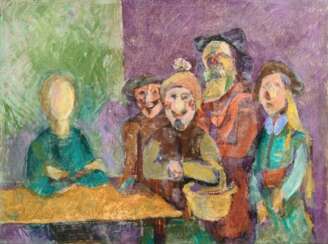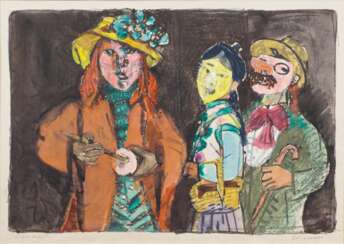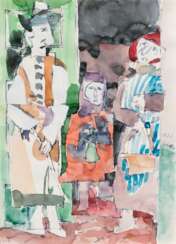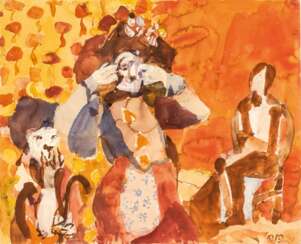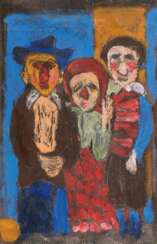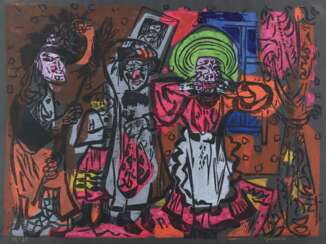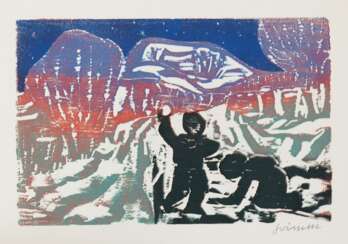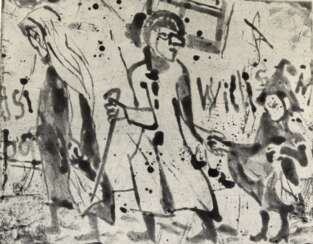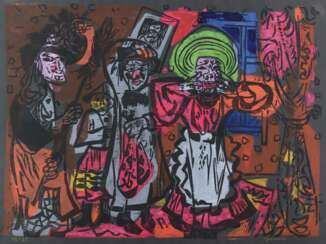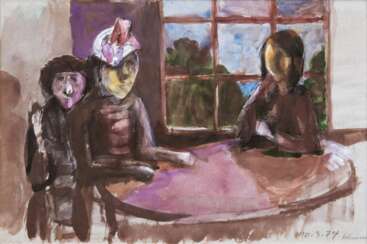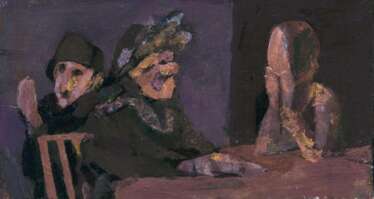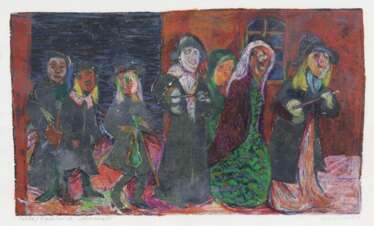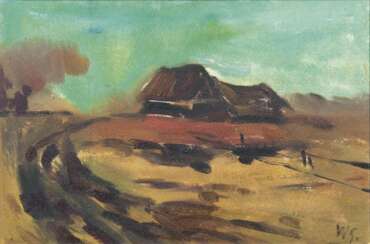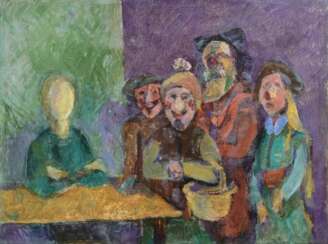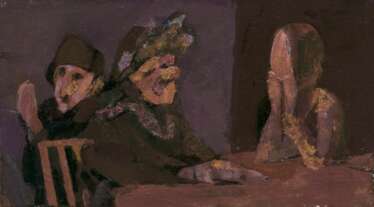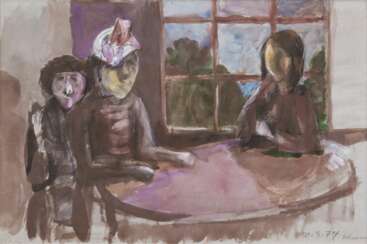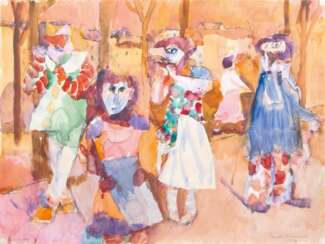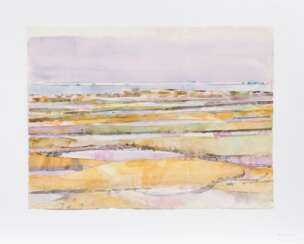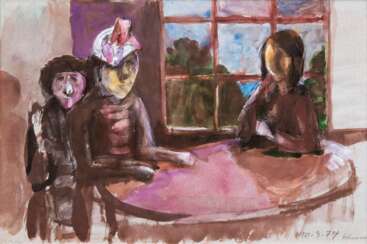виллем гримм (1904 - 1986)
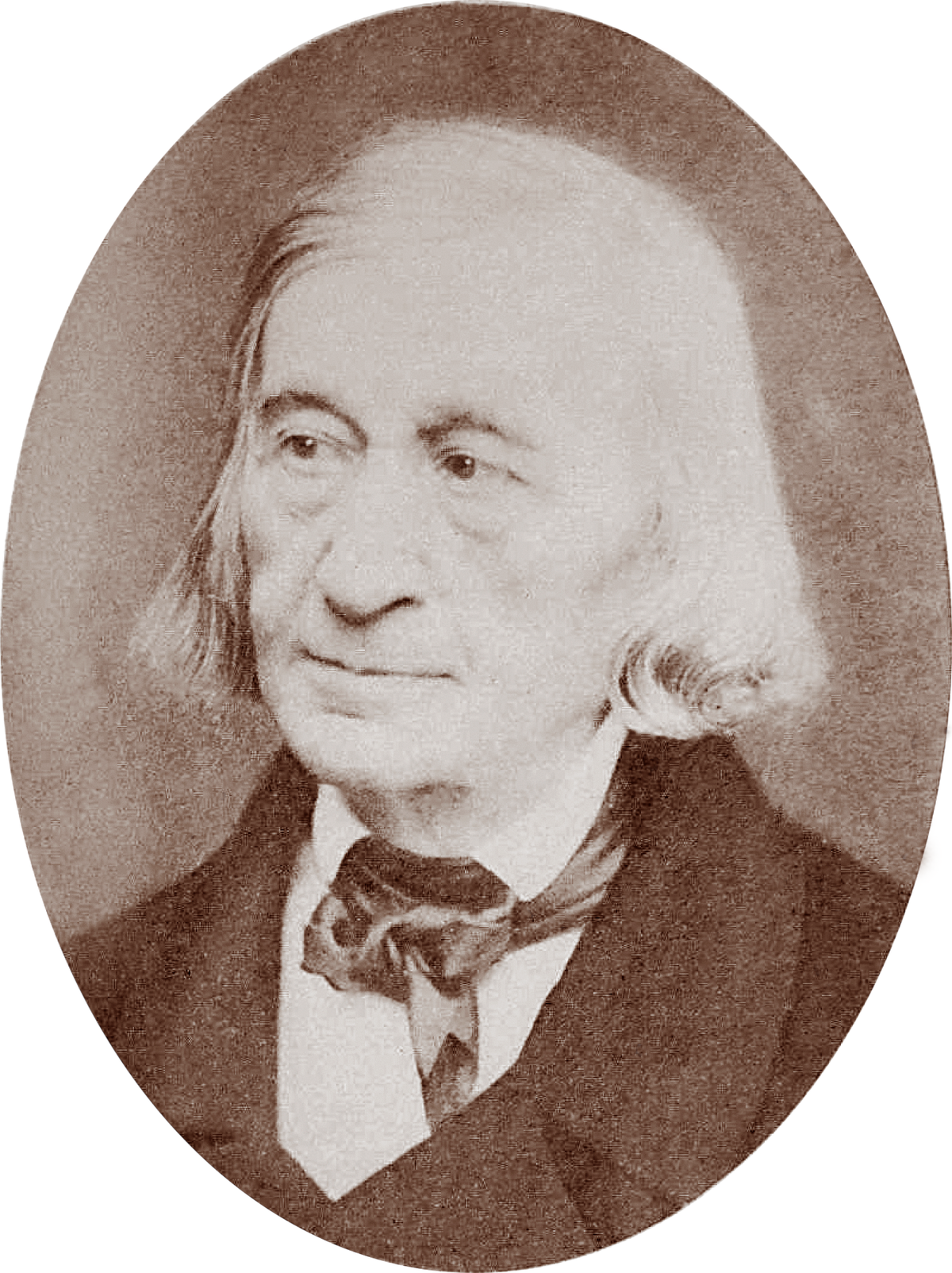
Willem Grimm was a German painter and graphic artist.
Already during his studies he made a name for himself, especially with his experimental graphics. After several guest exhibitions at the Hamburg Secession, he became an official member in 1929/30. In the early 1930s, at the age of 27, he was already one of Hamburg's most important artists.
In addition to classical genres such as portraits, landscapes and still lifes, Grimm worked from 1931 on the Rummelpott-Szenen motif, which in time became characteristic of his work.
The National Socialist repressions affected Willem Grimm less than many of his fellow artists. Still, in 1937 seven of Grimm's works were confiscated from the Kunsthalle Hamburg, the Hamburg Arts and Crafts Museum and the Nissenhaus Husum Museum as part of the "Degenerate Art" campaign and subsequently destroyed.
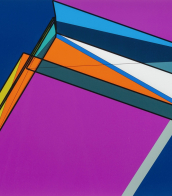

Willem Grimm was a German painter and graphic artist.
Already during his studies he made a name for himself, especially with his experimental graphics. After several guest exhibitions at the Hamburg Secession, he became an official member in 1929/30. In the early 1930s, at the age of 27, he was already one of Hamburg's most important artists.
In addition to classical genres such as portraits, landscapes and still lifes, Grimm worked from 1931 on the Rummelpott-Szenen motif, which in time became characteristic of his work.
The National Socialist repressions affected Willem Grimm less than many of his fellow artists. Still, in 1937 seven of Grimm's works were confiscated from the Kunsthalle Hamburg, the Hamburg Arts and Crafts Museum and the Nissenhaus Husum Museum as part of the "Degenerate Art" campaign and subsequently destroyed.
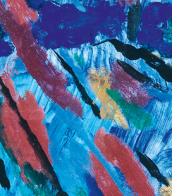

Willem Grimm was a German painter and graphic artist.
Already during his studies he made a name for himself, especially with his experimental graphics. After several guest exhibitions at the Hamburg Secession, he became an official member in 1929/30. In the early 1930s, at the age of 27, he was already one of Hamburg's most important artists.
In addition to classical genres such as portraits, landscapes and still lifes, Grimm worked from 1931 on the Rummelpott-Szenen motif, which in time became characteristic of his work.
The National Socialist repressions affected Willem Grimm less than many of his fellow artists. Still, in 1937 seven of Grimm's works were confiscated from the Kunsthalle Hamburg, the Hamburg Arts and Crafts Museum and the Nissenhaus Husum Museum as part of the "Degenerate Art" campaign and subsequently destroyed.


Willem Grimm was a German painter and graphic artist.
Already during his studies he made a name for himself, especially with his experimental graphics. After several guest exhibitions at the Hamburg Secession, he became an official member in 1929/30. In the early 1930s, at the age of 27, he was already one of Hamburg's most important artists.
In addition to classical genres such as portraits, landscapes and still lifes, Grimm worked from 1931 on the Rummelpott-Szenen motif, which in time became characteristic of his work.
The National Socialist repressions affected Willem Grimm less than many of his fellow artists. Still, in 1937 seven of Grimm's works were confiscated from the Kunsthalle Hamburg, the Hamburg Arts and Crafts Museum and the Nissenhaus Husum Museum as part of the "Degenerate Art" campaign and subsequently destroyed.


Willem Grimm was a German painter and graphic artist.
Already during his studies he made a name for himself, especially with his experimental graphics. After several guest exhibitions at the Hamburg Secession, he became an official member in 1929/30. In the early 1930s, at the age of 27, he was already one of Hamburg's most important artists.
In addition to classical genres such as portraits, landscapes and still lifes, Grimm worked from 1931 on the Rummelpott-Szenen motif, which in time became characteristic of his work.
The National Socialist repressions affected Willem Grimm less than many of his fellow artists. Still, in 1937 seven of Grimm's works were confiscated from the Kunsthalle Hamburg, the Hamburg Arts and Crafts Museum and the Nissenhaus Husum Museum as part of the "Degenerate Art" campaign and subsequently destroyed.


Willem Grimm was a German painter and graphic artist.
Already during his studies he made a name for himself, especially with his experimental graphics. After several guest exhibitions at the Hamburg Secession, he became an official member in 1929/30. In the early 1930s, at the age of 27, he was already one of Hamburg's most important artists.
In addition to classical genres such as portraits, landscapes and still lifes, Grimm worked from 1931 on the Rummelpott-Szenen motif, which in time became characteristic of his work.
The National Socialist repressions affected Willem Grimm less than many of his fellow artists. Still, in 1937 seven of Grimm's works were confiscated from the Kunsthalle Hamburg, the Hamburg Arts and Crafts Museum and the Nissenhaus Husum Museum as part of the "Degenerate Art" campaign and subsequently destroyed.


Willem Grimm was a German painter and graphic artist.
Already during his studies he made a name for himself, especially with his experimental graphics. After several guest exhibitions at the Hamburg Secession, he became an official member in 1929/30. In the early 1930s, at the age of 27, he was already one of Hamburg's most important artists.
In addition to classical genres such as portraits, landscapes and still lifes, Grimm worked from 1931 on the Rummelpott-Szenen motif, which in time became characteristic of his work.
The National Socialist repressions affected Willem Grimm less than many of his fellow artists. Still, in 1937 seven of Grimm's works were confiscated from the Kunsthalle Hamburg, the Hamburg Arts and Crafts Museum and the Nissenhaus Husum Museum as part of the "Degenerate Art" campaign and subsequently destroyed.
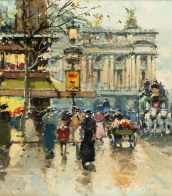

Willem Grimm was a German painter and graphic artist.
Already during his studies he made a name for himself, especially with his experimental graphics. After several guest exhibitions at the Hamburg Secession, he became an official member in 1929/30. In the early 1930s, at the age of 27, he was already one of Hamburg's most important artists.
In addition to classical genres such as portraits, landscapes and still lifes, Grimm worked from 1931 on the Rummelpott-Szenen motif, which in time became characteristic of his work.
The National Socialist repressions affected Willem Grimm less than many of his fellow artists. Still, in 1937 seven of Grimm's works were confiscated from the Kunsthalle Hamburg, the Hamburg Arts and Crafts Museum and the Nissenhaus Husum Museum as part of the "Degenerate Art" campaign and subsequently destroyed.


Willem Grimm was a German painter and graphic artist.
Already during his studies he made a name for himself, especially with his experimental graphics. After several guest exhibitions at the Hamburg Secession, he became an official member in 1929/30. In the early 1930s, at the age of 27, he was already one of Hamburg's most important artists.
In addition to classical genres such as portraits, landscapes and still lifes, Grimm worked from 1931 on the Rummelpott-Szenen motif, which in time became characteristic of his work.
The National Socialist repressions affected Willem Grimm less than many of his fellow artists. Still, in 1937 seven of Grimm's works were confiscated from the Kunsthalle Hamburg, the Hamburg Arts and Crafts Museum and the Nissenhaus Husum Museum as part of the "Degenerate Art" campaign and subsequently destroyed.


Willem Grimm was a German painter and graphic artist.
Already during his studies he made a name for himself, especially with his experimental graphics. After several guest exhibitions at the Hamburg Secession, he became an official member in 1929/30. In the early 1930s, at the age of 27, he was already one of Hamburg's most important artists.
In addition to classical genres such as portraits, landscapes and still lifes, Grimm worked from 1931 on the Rummelpott-Szenen motif, which in time became characteristic of his work.
The National Socialist repressions affected Willem Grimm less than many of his fellow artists. Still, in 1937 seven of Grimm's works were confiscated from the Kunsthalle Hamburg, the Hamburg Arts and Crafts Museum and the Nissenhaus Husum Museum as part of the "Degenerate Art" campaign and subsequently destroyed.


Willem Grimm was a German painter and graphic artist.
Already during his studies he made a name for himself, especially with his experimental graphics. After several guest exhibitions at the Hamburg Secession, he became an official member in 1929/30. In the early 1930s, at the age of 27, he was already one of Hamburg's most important artists.
In addition to classical genres such as portraits, landscapes and still lifes, Grimm worked from 1931 on the Rummelpott-Szenen motif, which in time became characteristic of his work.
The National Socialist repressions affected Willem Grimm less than many of his fellow artists. Still, in 1937 seven of Grimm's works were confiscated from the Kunsthalle Hamburg, the Hamburg Arts and Crafts Museum and the Nissenhaus Husum Museum as part of the "Degenerate Art" campaign and subsequently destroyed.


Willem Grimm was a German painter and graphic artist.
Already during his studies he made a name for himself, especially with his experimental graphics. After several guest exhibitions at the Hamburg Secession, he became an official member in 1929/30. In the early 1930s, at the age of 27, he was already one of Hamburg's most important artists.
In addition to classical genres such as portraits, landscapes and still lifes, Grimm worked from 1931 on the Rummelpott-Szenen motif, which in time became characteristic of his work.
The National Socialist repressions affected Willem Grimm less than many of his fellow artists. Still, in 1937 seven of Grimm's works were confiscated from the Kunsthalle Hamburg, the Hamburg Arts and Crafts Museum and the Nissenhaus Husum Museum as part of the "Degenerate Art" campaign and subsequently destroyed.


Willem Grimm was a German painter and graphic artist.
Already during his studies he made a name for himself, especially with his experimental graphics. After several guest exhibitions at the Hamburg Secession, he became an official member in 1929/30. In the early 1930s, at the age of 27, he was already one of Hamburg's most important artists.
In addition to classical genres such as portraits, landscapes and still lifes, Grimm worked from 1931 on the Rummelpott-Szenen motif, which in time became characteristic of his work.
The National Socialist repressions affected Willem Grimm less than many of his fellow artists. Still, in 1937 seven of Grimm's works were confiscated from the Kunsthalle Hamburg, the Hamburg Arts and Crafts Museum and the Nissenhaus Husum Museum as part of the "Degenerate Art" campaign and subsequently destroyed.
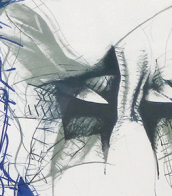

Willem Grimm was a German painter and graphic artist.
Already during his studies he made a name for himself, especially with his experimental graphics. After several guest exhibitions at the Hamburg Secession, he became an official member in 1929/30. In the early 1930s, at the age of 27, he was already one of Hamburg's most important artists.
In addition to classical genres such as portraits, landscapes and still lifes, Grimm worked from 1931 on the Rummelpott-Szenen motif, which in time became characteristic of his work.
The National Socialist repressions affected Willem Grimm less than many of his fellow artists. Still, in 1937 seven of Grimm's works were confiscated from the Kunsthalle Hamburg, the Hamburg Arts and Crafts Museum and the Nissenhaus Husum Museum as part of the "Degenerate Art" campaign and subsequently destroyed.


Willem Grimm was a German painter and graphic artist.
Already during his studies he made a name for himself, especially with his experimental graphics. After several guest exhibitions at the Hamburg Secession, he became an official member in 1929/30. In the early 1930s, at the age of 27, he was already one of Hamburg's most important artists.
In addition to classical genres such as portraits, landscapes and still lifes, Grimm worked from 1931 on the Rummelpott-Szenen motif, which in time became characteristic of his work.
The National Socialist repressions affected Willem Grimm less than many of his fellow artists. Still, in 1937 seven of Grimm's works were confiscated from the Kunsthalle Hamburg, the Hamburg Arts and Crafts Museum and the Nissenhaus Husum Museum as part of the "Degenerate Art" campaign and subsequently destroyed.
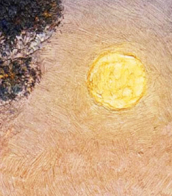

Willem Grimm was a German painter and graphic artist.
Already during his studies he made a name for himself, especially with his experimental graphics. After several guest exhibitions at the Hamburg Secession, he became an official member in 1929/30. In the early 1930s, at the age of 27, he was already one of Hamburg's most important artists.
In addition to classical genres such as portraits, landscapes and still lifes, Grimm worked from 1931 on the Rummelpott-Szenen motif, which in time became characteristic of his work.
The National Socialist repressions affected Willem Grimm less than many of his fellow artists. Still, in 1937 seven of Grimm's works were confiscated from the Kunsthalle Hamburg, the Hamburg Arts and Crafts Museum and the Nissenhaus Husum Museum as part of the "Degenerate Art" campaign and subsequently destroyed.


Willem Grimm was a German painter and graphic artist.
Already during his studies he made a name for himself, especially with his experimental graphics. After several guest exhibitions at the Hamburg Secession, he became an official member in 1929/30. In the early 1930s, at the age of 27, he was already one of Hamburg's most important artists.
In addition to classical genres such as portraits, landscapes and still lifes, Grimm worked from 1931 on the Rummelpott-Szenen motif, which in time became characteristic of his work.
The National Socialist repressions affected Willem Grimm less than many of his fellow artists. Still, in 1937 seven of Grimm's works were confiscated from the Kunsthalle Hamburg, the Hamburg Arts and Crafts Museum and the Nissenhaus Husum Museum as part of the "Degenerate Art" campaign and subsequently destroyed.


Willem Grimm was a German painter and graphic artist.
Already during his studies he made a name for himself, especially with his experimental graphics. After several guest exhibitions at the Hamburg Secession, he became an official member in 1929/30. In the early 1930s, at the age of 27, he was already one of Hamburg's most important artists.
In addition to classical genres such as portraits, landscapes and still lifes, Grimm worked from 1931 on the Rummelpott-Szenen motif, which in time became characteristic of his work.
The National Socialist repressions affected Willem Grimm less than many of his fellow artists. Still, in 1937 seven of Grimm's works were confiscated from the Kunsthalle Hamburg, the Hamburg Arts and Crafts Museum and the Nissenhaus Husum Museum as part of the "Degenerate Art" campaign and subsequently destroyed.


Willem Grimm was a German painter and graphic artist.
Already during his studies he made a name for himself, especially with his experimental graphics. After several guest exhibitions at the Hamburg Secession, he became an official member in 1929/30. In the early 1930s, at the age of 27, he was already one of Hamburg's most important artists.
In addition to classical genres such as portraits, landscapes and still lifes, Grimm worked from 1931 on the Rummelpott-Szenen motif, which in time became characteristic of his work.
The National Socialist repressions affected Willem Grimm less than many of his fellow artists. Still, in 1937 seven of Grimm's works were confiscated from the Kunsthalle Hamburg, the Hamburg Arts and Crafts Museum and the Nissenhaus Husum Museum as part of the "Degenerate Art" campaign and subsequently destroyed.
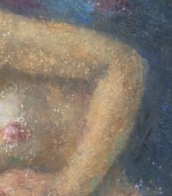

Willem Grimm was a German painter and graphic artist.
Already during his studies he made a name for himself, especially with his experimental graphics. After several guest exhibitions at the Hamburg Secession, he became an official member in 1929/30. In the early 1930s, at the age of 27, he was already one of Hamburg's most important artists.
In addition to classical genres such as portraits, landscapes and still lifes, Grimm worked from 1931 on the Rummelpott-Szenen motif, which in time became characteristic of his work.
The National Socialist repressions affected Willem Grimm less than many of his fellow artists. Still, in 1937 seven of Grimm's works were confiscated from the Kunsthalle Hamburg, the Hamburg Arts and Crafts Museum and the Nissenhaus Husum Museum as part of the "Degenerate Art" campaign and subsequently destroyed.


Willem Grimm was a German painter and graphic artist.
Already during his studies he made a name for himself, especially with his experimental graphics. After several guest exhibitions at the Hamburg Secession, he became an official member in 1929/30. In the early 1930s, at the age of 27, he was already one of Hamburg's most important artists.
In addition to classical genres such as portraits, landscapes and still lifes, Grimm worked from 1931 on the Rummelpott-Szenen motif, which in time became characteristic of his work.
The National Socialist repressions affected Willem Grimm less than many of his fellow artists. Still, in 1937 seven of Grimm's works were confiscated from the Kunsthalle Hamburg, the Hamburg Arts and Crafts Museum and the Nissenhaus Husum Museum as part of the "Degenerate Art" campaign and subsequently destroyed.


Willem Grimm was a German painter and graphic artist.
Already during his studies he made a name for himself, especially with his experimental graphics. After several guest exhibitions at the Hamburg Secession, he became an official member in 1929/30. In the early 1930s, at the age of 27, he was already one of Hamburg's most important artists.
In addition to classical genres such as portraits, landscapes and still lifes, Grimm worked from 1931 on the Rummelpott-Szenen motif, which in time became characteristic of his work.
The National Socialist repressions affected Willem Grimm less than many of his fellow artists. Still, in 1937 seven of Grimm's works were confiscated from the Kunsthalle Hamburg, the Hamburg Arts and Crafts Museum and the Nissenhaus Husum Museum as part of the "Degenerate Art" campaign and subsequently destroyed.


Willem Grimm was a German painter and graphic artist.
Already during his studies he made a name for himself, especially with his experimental graphics. After several guest exhibitions at the Hamburg Secession, he became an official member in 1929/30. In the early 1930s, at the age of 27, he was already one of Hamburg's most important artists.
In addition to classical genres such as portraits, landscapes and still lifes, Grimm worked from 1931 on the Rummelpott-Szenen motif, which in time became characteristic of his work.
The National Socialist repressions affected Willem Grimm less than many of his fellow artists. Still, in 1937 seven of Grimm's works were confiscated from the Kunsthalle Hamburg, the Hamburg Arts and Crafts Museum and the Nissenhaus Husum Museum as part of the "Degenerate Art" campaign and subsequently destroyed.


Willem Grimm was a German painter and graphic artist.
Already during his studies he made a name for himself, especially with his experimental graphics. After several guest exhibitions at the Hamburg Secession, he became an official member in 1929/30. In the early 1930s, at the age of 27, he was already one of Hamburg's most important artists.
In addition to classical genres such as portraits, landscapes and still lifes, Grimm worked from 1931 on the Rummelpott-Szenen motif, which in time became characteristic of his work.
The National Socialist repressions affected Willem Grimm less than many of his fellow artists. Still, in 1937 seven of Grimm's works were confiscated from the Kunsthalle Hamburg, the Hamburg Arts and Crafts Museum and the Nissenhaus Husum Museum as part of the "Degenerate Art" campaign and subsequently destroyed.
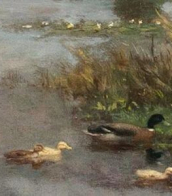

Willem Grimm was a German painter and graphic artist.
Already during his studies he made a name for himself, especially with his experimental graphics. After several guest exhibitions at the Hamburg Secession, he became an official member in 1929/30. In the early 1930s, at the age of 27, he was already one of Hamburg's most important artists.
In addition to classical genres such as portraits, landscapes and still lifes, Grimm worked from 1931 on the Rummelpott-Szenen motif, which in time became characteristic of his work.
The National Socialist repressions affected Willem Grimm less than many of his fellow artists. Still, in 1937 seven of Grimm's works were confiscated from the Kunsthalle Hamburg, the Hamburg Arts and Crafts Museum and the Nissenhaus Husum Museum as part of the "Degenerate Art" campaign and subsequently destroyed.
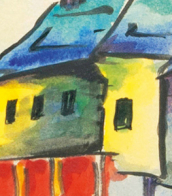

Willem Grimm was a German painter and graphic artist.
Already during his studies he made a name for himself, especially with his experimental graphics. After several guest exhibitions at the Hamburg Secession, he became an official member in 1929/30. In the early 1930s, at the age of 27, he was already one of Hamburg's most important artists.
In addition to classical genres such as portraits, landscapes and still lifes, Grimm worked from 1931 on the Rummelpott-Szenen motif, which in time became characteristic of his work.
The National Socialist repressions affected Willem Grimm less than many of his fellow artists. Still, in 1937 seven of Grimm's works were confiscated from the Kunsthalle Hamburg, the Hamburg Arts and Crafts Museum and the Nissenhaus Husum Museum as part of the "Degenerate Art" campaign and subsequently destroyed.


Willem Grimm was a German painter and graphic artist.
Already during his studies he made a name for himself, especially with his experimental graphics. After several guest exhibitions at the Hamburg Secession, he became an official member in 1929/30. In the early 1930s, at the age of 27, he was already one of Hamburg's most important artists.
In addition to classical genres such as portraits, landscapes and still lifes, Grimm worked from 1931 on the Rummelpott-Szenen motif, which in time became characteristic of his work.
The National Socialist repressions affected Willem Grimm less than many of his fellow artists. Still, in 1937 seven of Grimm's works were confiscated from the Kunsthalle Hamburg, the Hamburg Arts and Crafts Museum and the Nissenhaus Husum Museum as part of the "Degenerate Art" campaign and subsequently destroyed.


Willem Grimm was a German painter and graphic artist.
Already during his studies he made a name for himself, especially with his experimental graphics. After several guest exhibitions at the Hamburg Secession, he became an official member in 1929/30. In the early 1930s, at the age of 27, he was already one of Hamburg's most important artists.
In addition to classical genres such as portraits, landscapes and still lifes, Grimm worked from 1931 on the Rummelpott-Szenen motif, which in time became characteristic of his work.
The National Socialist repressions affected Willem Grimm less than many of his fellow artists. Still, in 1937 seven of Grimm's works were confiscated from the Kunsthalle Hamburg, the Hamburg Arts and Crafts Museum and the Nissenhaus Husum Museum as part of the "Degenerate Art" campaign and subsequently destroyed.


Willem Grimm was a German painter and graphic artist.
Already during his studies he made a name for himself, especially with his experimental graphics. After several guest exhibitions at the Hamburg Secession, he became an official member in 1929/30. In the early 1930s, at the age of 27, he was already one of Hamburg's most important artists.
In addition to classical genres such as portraits, landscapes and still lifes, Grimm worked from 1931 on the Rummelpott-Szenen motif, which in time became characteristic of his work.
The National Socialist repressions affected Willem Grimm less than many of his fellow artists. Still, in 1937 seven of Grimm's works were confiscated from the Kunsthalle Hamburg, the Hamburg Arts and Crafts Museum and the Nissenhaus Husum Museum as part of the "Degenerate Art" campaign and subsequently destroyed.


Willem Grimm was a German painter and graphic artist.
Already during his studies he made a name for himself, especially with his experimental graphics. After several guest exhibitions at the Hamburg Secession, he became an official member in 1929/30. In the early 1930s, at the age of 27, he was already one of Hamburg's most important artists.
In addition to classical genres such as portraits, landscapes and still lifes, Grimm worked from 1931 on the Rummelpott-Szenen motif, which in time became characteristic of his work.
The National Socialist repressions affected Willem Grimm less than many of his fellow artists. Still, in 1937 seven of Grimm's works were confiscated from the Kunsthalle Hamburg, the Hamburg Arts and Crafts Museum and the Nissenhaus Husum Museum as part of the "Degenerate Art" campaign and subsequently destroyed.

